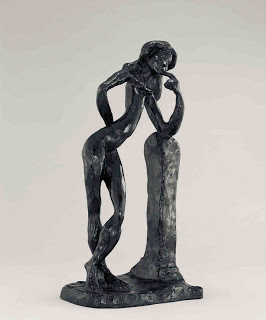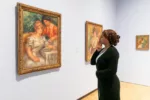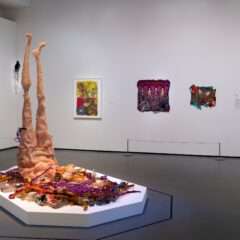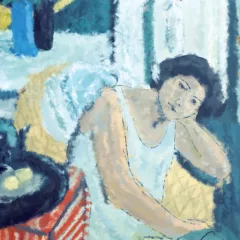Two very different exhibitions are making their only East Coast appearances in Baltimore at the moment; either would be worth the trip. For anyone who shares my breadth of interests, the two are a must-see double-bill.

Edward Steichen Matisse with plaster cast of The Serpentine, Issy-les-Moulineaux (1909) Archives Matisse, Paris. ©2007 Succession H. Matisse, Paris/Artists Rights Society (ARS), New York
Matisse: Painter as Sculptor
If Matisse’s only efforts as a sculptor were his four monumental reliefs (The Back, I – IV, 1909-1930, which are actually four states of one, evolving idea) he would be one of the great sculptors of the Twentieth Century. But he produced a much more substantial and important body of sculpture: 82 works, 60 of which are in the exhibition, Matisse: Painter as Sculptor at the Baltimore Museum of Art (BMA) through Feb. 3, 2008, along with many related drawings, paintings, prints and paper-cuts, comparative sculptures by his contemporaries (including Maillol, Picasso, Brancusi), and important precedents by Rodin and Barye. The first exhibition to focus on his sculpture in twenty years, it includes variants of subjects that Matisse returned to again and again as well as multiple impressions that reveal differences in casting technique and one of his very rare, original plasters. It is not to be missed by anyone interested in Matisse or in modernist art in general.

Henri Matisse The Back III (1916–1917, cast 1964), bronze, 75″ x 45″ x 6 ½”, Franklin D. Murphy Sculpture Garden, University of California, Los Angeles; Gift of the UCLA Art Council through the generosity of Mrs. Robert E. Gross and Mrs. Charles E. Ducommun; Courtesy of the Hammer Museum, photo by Robert Wedermeyer. ©2007 Succession H. Matisse, Paris/Artists Rights Society (ARS), New York
I suspect Matisse’s sculpture has been overlooked because of its scale; other than The Back he produced table-top sculpture during a century that associated such work with the de-valued decorative arts. Another problem is the sculpture’s unaccommodating rigor; viewers seem willing to overlook the difficulty of Matisse’s most challenging paintings because of the extreme seductiveness of their colors, which the sculptures cannot hide behind . The modesty of size in no way diminishes the power of the sculpture, which is every bit as tough and challenging as his major paintings and paper-cuts. When hundred-year-old work is still this difficult, it repays intense study.
Matisse’s training included the standard academic project of copying a master-work from the Louvre. He selected a piece by the animalier, Barye and studied it with his eyes blindfolded; Matisse wanted to sculpt with his hands, not his eyes. The exhibition reveals that as he matured he drew on both senses in a non-hierarchical way for work in two and three dimensions.

As early as 1903 we can see evidence of his hand operating independently of his eye: the hair-do of Madeleine II was obviously sliced by the sculpting-tool and the cleft of her backbone reveals where the artist’s fingers pulled the clay apart. The backbone clearly had a conceptual importance for the artist who exaggerated its physical manifestation again and again – either as a deep cleft, or inversely, as a protruding column in Back III and IV. He was just as free in manipulating arms, legs and torsos: in works, such as The Serpentine, he twists the forms of the body with the freedom and expressiveness of strokes in a chalk drawing.

Henri Matisse Small Thin Torso (1929, cast 1930), bronze,
3 1/8″, The Baltimore Museum of Art
There are two extraordinary pieces, both from 1929, which indicate another way in which Matisse’s sculpture transcended the eye: Small Torso and Small Thin Torso (the later a recent purchase by the BMA) are both less than 4″ in height. The catalogue suggests that Matisse made them in response to a Roman torso which he owned, but I see them as fetishes, works of spiritual power made to be cupped in the palm, and wonder whether they don’t owe something to the Venus of Willendorf (whose voluptous forms are a mere 4 3/8″ high) , which had been excavated in 1908.
The exhibition was organized by the BMA , the Dallas Museum of Art and the Nasher Sculpture Center, who have produced a beautiful catalogue that includes multiple essays and the first study devoted to a technical examination of Matisses’ bronzes (by Oliver Shell and Ann Boulton, of the BMA). The exhibition, which is beautifully-installed, includes a short and very clear video on the process Matisse used in modeling and casting his sculpture as well as a demonstration of the use of laser technology to compare multiple casts. Visitors can also use a computer program which enables them to manipulate each piece virtually, viewing it from all sides.
Art and Politics from the 60s

Pirkle Jones Untitled Courtesy of Yerba Buena Center for the Arts
Maryland Institute College of Art‘s Decker and Meyerhoff Galleries is exhibiting Black Panther Rank and File through Dec. 16. The exhibition examines the uses of art (such as Emory Douglas’ posters and newspaper illustrations) to support the political activities of the Black Panther Party in the 1960s and the Black Panthers and their political goals as subjects for later art. It includes work by artists of several generations from Elizabeth Cattlett, David Hammons, Lawrence Weiner and Leon Golub to Kerry James Marshall, Carrie Mae Weems, Daniel Joseph Martinez and Liz Magor.

Emory Douglas Illustration for The Black Panther Paper
The exhibition seamlessly intermixes art and documentary material (photographs, broadsides, banners, oral histories). All the work is labeled, but the exhibition is free of didactic texts telling viewers what to think. On one wall hang a row of photographs documenting the civil rights movement; in their midst is a Warhol serigraph based on a famous press photograph of Birmingham race riots. This is an unusual but appropriate presentation which mirrors the fluid boundaries of art and politics within the Black Panther Party and by later (and a few earlier) artists concerned with the Panthers, the history of African Americans, and the broader civil rights movement.

Daniel Joseph Martinez We wanted to be (2005) vinyl 121″ x 81 1/2″, courtesy of the artist
Michael Britto’s video Dirty Harriet Tubman is a take-off on a Blaxploitation film that inter-cuts historical and contemporary events with racial stereotypes, revenge fantasies, pop music, traditional ballads and a fictitious teaser for a film about Tubman. Sam Durant produced a full-scale model, Proposal for a Monument to Huey P. Newton (2004-06), that asks the public to assume Newton’s place; the monument was neither proposed (except by the artist), nor built.
Perhaps the paradigmatic work in the exhibition is Coco Fusco’s 2004 video a/k/a Mrs. George Gilbert. The title derives from an alias used by Angela Davis when she was wanted by the FBI and went underground. It inter-cuts documentary footage, re-enactments, an imaginary conversation with an FBI agent who followed Davis, clips from the surveillance film, The Conversation, and a narrative by Fusco who muses on the position of Davis, an academic philosopher who reluctantly entered the political arena, and questions why it is that Davis is best-remembered for her hairstyle.
Black Panther Rank and File was organized by the Yerba Buena Center for the Arts, San Francisco (in conjunction with a curator from the Jack Shainman Gallery, New York which supplied a good deal of the material). MICA has supplemented it with oral histories (available on Walkmen in the exhibition, or on the web-site), produced by students in the Community Arts program. Students interviewed Baltimore residents with long involvement in the Black Panther Party. While the mainstream media always emphasized the violent politics of the Panthers, the interviewees describe the Panthers’ many social service activities including pre-schools, health clinics and nutrition programs. Philadelphia native, Sandi McFadden, recounts how spirituality put her politics into perspective, revealing it as a means for self-discovery and empowerment.
While Black Panther Rank and File is generally supportive of the Panthers and their cause, it allows for questions and criticism of the Party’s stance on homosexuality and its exclusion of women from leadership roles, although it sidesteps questions about its use of violence. The exhibition is significant in filling in a history of American racial problems which remain unfortunately unresolved. It also provides various models of challenging art which engages with current political concerns and addresses a broad public.








